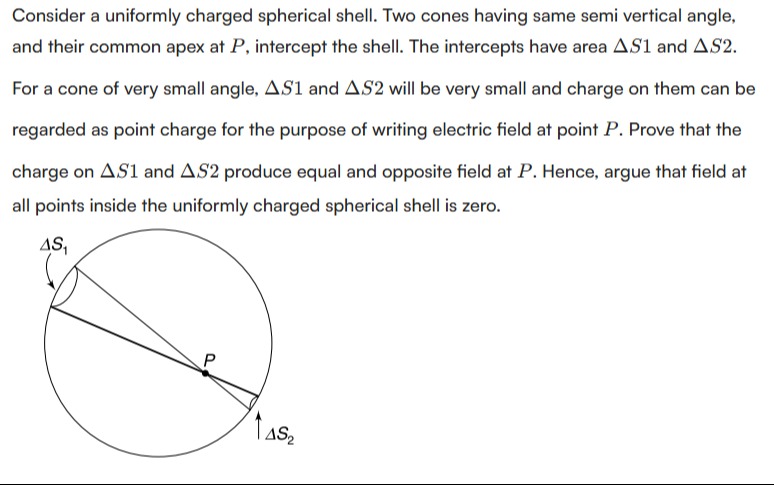Question
Question: Consider a uniformly charged spherical shell. Two cones having same semi vertical angle, and their c...
Consider a uniformly charged spherical shell. Two cones having same semi vertical angle, and their common apex at P, intercept the shell. The intercepts have area ΔS1 and ΔS2. For a cone of very small angle, ΔS1 and ΔS2 will be very small and charge on them can be regarded as point charge for the purpose of writing electric field at point P. Prove that the charge on ΔS1 and ΔS2 produce equal and opposite field at P. Hence, argue that field at all points inside the uniformly charged spherical shell is zero.

The charge on ΔS1 and ΔS2 produce equal and opposite field at P. Hence, the field at all points inside the uniformly charged spherical shell is zero.
Solution
Let P be a point inside the uniformly charged spherical shell. Consider a small cone with apex at P and a small solid angle ΔΩ. This cone intercepts two small areas ΔS1 and ΔS2 on the spherical shell. Let the distances from P to these areas be r1 and r2, respectively. Since the cone is very small, ΔS1 and ΔS2 can be considered as approximately planar.
The solid angle ΔΩ subtended by an area element ΔS at a point P at a distance r is given by ΔΩ=r2ΔScosα, where α is the angle between the normal to the area element and the line connecting P to the area element.
For the area ΔS1, let the angle between the line from P to ΔS1 and the outward normal to the shell at ΔS1 be α1. Then ΔΩ=r12ΔS1cosα1.
For the area ΔS2, let the angle between the line from P to ΔS2 and the outward normal to the shell at ΔS2 be α2. Then ΔΩ=r22ΔS2cosα2.
Since the solid angle is the same for both intercepts, we have r12ΔS1cosα1=r22ΔS2cosα2.
Consider the line passing through P and the centers of ΔS1 and ΔS2. Let this line intersect the spherical shell at points A and B, where A is associated with ΔS1 and B is associated with ΔS2. Let O be the center of the spherical shell. The outward normal at any point on the shell is along the line connecting that point to O. Let the line segment APB make an angle θ with the line PO.
Consider the angles α1 and α2. It can be shown that cosα1=cosα2.
We have r12cosα1ΔS1=r22cosα2ΔS2.
Let's use the fact that ΔΩ=r2ΔScosα.
We need to show r12ΔS1=r22ΔS2. This is equivalent to showing ΔΩcosα1=ΔΩcosα2, which means cosα1=cosα2.
From r12ΔS1cosα1=r22ΔS2cosα2 and cosα1=cosα2=0, we get r12ΔS1=r22ΔS2.
The charge on ΔS1 is Δq1=σΔS1. The electric field at P due to Δq1 is ΔE1=4πϵ01r12Δq1r^1=4πϵ01r12σΔS1r^1.
The charge on ΔS2 is Δq2=σΔS2. The electric field at P due to Δq2 is ΔE2=4πϵ01r22Δq2r^2=4πϵ01r22σΔS2r^2.
Since the points are on a line through P, the unit vectors are opposite in direction, i.e., r^2=−r^1.
So, ΔE1=4πϵ0σr12ΔS1r^1 and ΔE2=4πϵ0σr22ΔS2(−r^1).
Since r12ΔS1=r22ΔS2, we have ∣ΔE1∣=4πϵ0σr12ΔS1 and ∣ΔE2∣=4πϵ0σr22ΔS2=4πϵ0σr12ΔS1=∣ΔE1∣.
Also, ΔE2=−4πϵ0σr12ΔS1r^1=−ΔE1.
Thus, the charge on ΔS1 and ΔS2 produce equal and opposite electric fields at P.
To argue that the field at all points inside the uniformly charged spherical shell is zero, we can consider any point P inside the shell. We can divide the entire spherical shell into pairs of areas intercepted by small cones with apex at P and the same solid angle. For each pair of areas ΔS1 and ΔS2 intercepted by a cone, the electric fields produced at P are equal in magnitude and opposite in direction, so they cancel each other out. By summing over all such pairs of areas that make up the entire spherical shell, the net electric field at P is the vector sum of all these canceling pairs, which is zero. Since this holds for any point P inside the spherical shell, the electric field at all points inside the uniformly charged spherical shell is zero.
